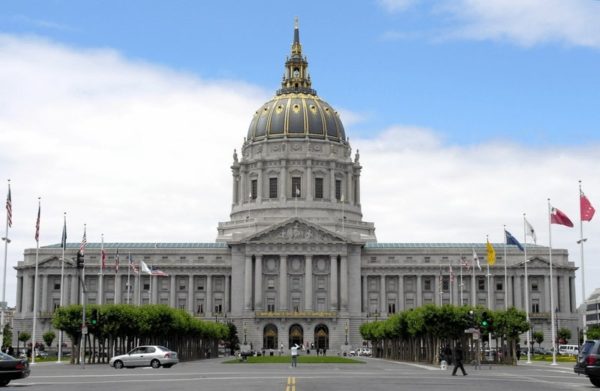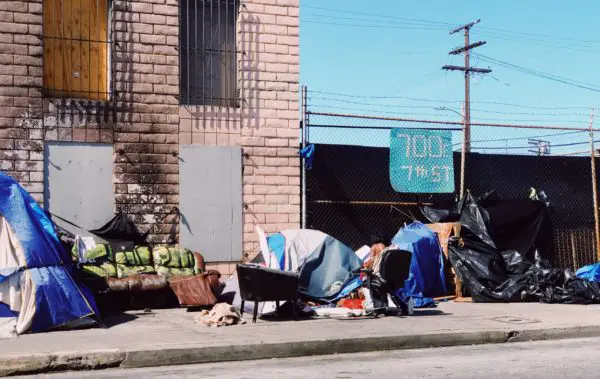Table of Contents ![]()
- 1 Boards Solution
- 1.1 Opposition and Support
- 1.2 The CEO Tax Solution
- 1.3 Homeless Living from Cars
- 2 Are San Francisco’s Solutions Useful?
- 3 San Frans Lack of Affordable Housing
- 3.1 Zoning and Land Use Laws
- 3.2 Origins of Zoning
- 3.3 How Zoning affected San Fran
- 3.4 Zoning Impact on Homelessness
- 4 San Francisco’s Unemployment
- 4.1 Homelessness
San Francisco’s Homeless Crisis
The homeless rate in San Francisco reached over 9,700 people in 2019. That is an increase of 30 percent in two years. Such a large upsurge now brings the city’s homeless to among the highest in the USA. Over 1 percent of its population is homeless. Far greater than the national average of 0.17 percent.
The city is notoriously expensive to live in. Rent for an average apartment comes in at around $3,700 per month. Even those earning under $82,000 a year would classify as ‘low-income’. As a result, these high living costs have exasperated the homeless crisis. If people cannot afford a home, they either have to move to another state, or as many do; become homeless.
The Board’s Solution
SAN FRANCISCO’S CITY HALL

Source: Cabe6403 at English Wikipedia, licensed under the Creative Commons Attribution-Share Alike 3.0 Unported license
Proposition C
Much of the crisis in San Francisco is attributed to the ‘tech boom’ starting in 2011. In fact, the city’s Board of Advisors specifically blames such prosperous companies for the homeless and housing affordability crisis. A solution was proposed by the Advisors in 2018. Proposition C, as it is otherwise known, levies a 0.5 percent tax on companies whose revenues exceed $50 million. The proposition passed by a public vote of over 60 percent in November 2018. It is expected to raise between $250 million and $300 million in its first year. That would double the city’s existing expenditure of $250 million a year on the homeless.
Opposition and Support for Proposition C
The opposition to the proposal was mixed. San Francisco’s mayor, London Breed, and state Sen. Scott Wiener, both opposed the motion. Their opposition however, was largely on the basis that the motion does not use the monies in an effective manner. With the city already spending over $250 million a year already, they both argue that these resources should be used more efficiently, rather than dis-incentivising local business. The issue is with policy rather than the amount of resources available.
On the other side of the argument was the CEO of Salesforce, Marc Benioff. He personally donated $2 million, with Salesforce also contributing $6 million to the Proposition C campaign. With Saleforce being the largest employer in San Francisco, the public and financial backing gave the Proposition C campaign real clout. Mr Benioff wasn’t the only CEO to publicly support the move. Cisco Systems CEO, Chuck Robbins, also came out in favour of the proposal. In fact, Cisco delivered over $50 million to homeless charity ‘Destination’ in 2018.
JACK DORSEY vs MARC BENIOFF

Source: Quartz REUTERS/CHRIS WATTIE, REUTERS/MIKE BLAKE, TWITTER
There was also significant push back from notable tech companies. Twitter and Square CEO, Jack Dorsey, notably had a public spat with Marc Benioff. He criticised the proposition as he argued that it lack proper accountability and oversight. In addition, it would dis-proportionately affect financial service companies like Square. Dorsevs argument was that Square would be unfairly paying twice as much as Salesforce. With revenues of $3.3 billion, Square could face a bill of $20 million. Hardly significant in the grand scheme of thing; but it is the fairness that Dorsey has issue with. In comparison, Salesforce, with revenues of over $13 billion, would pay only $10 million — half of Square, yet 4 times the size.
So how does this work? Through a very complex tax system! Under Proposition E, San Francisco replaced a flat 1.5 percent tax on payrolls over $250,000, a replaced them with tax rates for 20 categories of businesses. As a result, retailers pay less than software businesses, which pay less than financial service companies. The 0.5 percent tax is based upon ‘gross receipts , which definition varies upon the categorisation of the business.
The CEO Tax Solution
The board of advisors succeeded in passing through Proposition C, but now have further ambitions. Supervisors Hillary Ronen and Matt Haney developed what has been named ‘the CEO tax’. The plan would tax companies who have higher CEO to employee pay gaps. The funds would then be diverted to mental health care for all. With the Board of Advisors passing the motion, the package is set to go for a public vote in March 2020.

Source: SFCHRONICLE Supervisor Hillary Ronen speaks with the Chronicle editorial board regarding their San Francisco mental health proposal at the San Francisco Chronicle offices in San Francisco, California, on Monday, June 10, 2019. Photo: Gabrielle Lurie / The Chronicle
The tax system works in a way by which companies with a CEO pay of 100 times the average wage, would pay 0.1 percent in tax. This would continue to go up in proportion to the CEO pay gap. For example, a CEO to employee ratio of 500 would equal a 0.5 percent tax. The city’s control offices expect this to raise up to $140 million a year.
Help For People Living out of their Cars
Another solution proposed by the Board Advisors was a ‘safe’ parking lot space for those homeless that are living out of their cars. The proposal would turn the parking lot near Balboa Park BART station into a refuge for the homeless who live in their vehicles. The city would build facilities in the parking lot such as bathrooms, showers, and case managers. In what is designed as a pilot programme, it would serve roughly 30 vehicles. If successful, the plan is to roll the scheme throughout the city to help the 600 homeless living from their vehicles.
Are San Francisco’s solutions useful?
It is fair to say that the Board of Advisors have been busy on coming up with numerous solutions. The logic from the citys Board of Advisors is that tech companies are the cause of the crisis. Therefore, they should also provide the solution. However, this is a mistaken analysis of both the cause and the solution to the crisis. Whilst further help for mental health is needed, it still doesn’t solve the underlying issue: housing and the cost of living.
Proposition C has no real clear purpose on how the money is expected to be spent. While $300 million will be raised, it is unlikely to improve the situation. In fact, a Bay Area Council Economic Institute report found that the city would need over $12 billion to eliminate homelessness. This includes the cost to house 9, 700 of the homeless, as well as financially support them.
Nan Roman, president and CEO of the National Alliance to End Homelessness, a Washington, D.C.- based advocacy group concluded:
“The real issue is there’s not enough affordable housing”, “And rents for modest apartments have increased much faster than low-income people’s incomes have gone up.”

Source: Photo by Brandi Ibrao on Unsplash
These solutions only resolve the consequence of existing laws. High house prices have priced many out of a home and onto the streets. By offering a generous housing policy, it will only attract other homeless people from the surrounding area. So this is not necessarily an effective solution. And while mental health support is welcomed, it hardly solves the cause. Put out of the job, unable to afford rent, and other such life changes circumstances would place a mental strain on many. It is part of the consequence.
The solutions proposed have looked to address problems that patches up a wound, rather than preventing it from happening. According to an annual survey by the U.S. Conference of Mayors, major cities report that top causes of homelessness were (1) lack of affordable housing, (2) unemployment, (3) poverty, and (4) low wages. Bringing in more money from tech businesses and re-distributing is not going to solve these more prominent problems.
San Francisco’s Lack of Affordable Housing
Affordable housing is the number one factor in contributing to homelessness. If we look at the US cities With high levels of homelessness, we see a strong connection with highly regulated housing. New York City, Los Angeles, Seattle, San Diego, and San Jose are where homelessness is a massive issue. They also have among the strictest zoning regulations in the country, When looking at other large cities, we find that zoning regulations are a possible cause. Houston for example has rather lax zoning regulations, and has little problems with affordability. The average rent is around $1,100 a month. That’s significantly less than the $3,600 in San Francisco.
It can be said that Houston is no San Francisco. But there is a clear correlation between house prices and zoning regulation. However, correlation does not always mean causation. So let’s see what the research says on the matter.
“Harvard economist, Edward Glaeser concluded that between 30 and 50 percent of the housing costs can be attributable to zoning and land use regulations.”
Harvard economist, Edward Glaeser, researched the impact that zoning regulation had on city’s such as: Manhattan, Los Angeles, and San Francisco. In his analysis, he concluded that between 30 and 50 percent of the housing costs can be attributable to zoning and land use regulations. A study by the National Association of Home Builders (NAHB), also found higher costs. However, these were not so extensive. It concluded that regulations account for 24.3 percent of the final price of a new single-family home. Salim Furth found similar findings in his study. He concluded that residents of coastal cities would pay 20 percent less in homeownership costs by adopting zoning regulations typical of the rest of the country.
Regulation appears to raise house prices, reduce construction, reduce the elasticity of housing supply, and alter urban form. Something that is glaringly obvious in San Francisco.
Now the cost of zoning and land-use regulation can vary depending on how restrictive they are. But one thing is consistent; they impact on prices. Here are a few: Edward L. Glaeser and Joseph Gyourko; C. Tsuriel Somerville and Christopher J. Mayer; Albert Saiz, et, al.
Zoning and Land Use Laws in San Francisco
In the post-war era, there was a strong drive towards ‘urban development’. The aim was to destroy slums, or ‘urban decay’, and replace them with higher class housing. Close to 12 million World War II veterans were due to come back after the war. Consequently, there was a dire need for housing. Part of the economic solution was based on Keynesian economics. Use government funding to boost the economy, whilst also resolving a housing shortage. The solution was to rid the city of run down housing, and revitalise it.

Fig. 1. Adaptation of San Francisco zoning map to demonstrate allowed level of residential construction. Source: https://sfzoning.deapthoughts.com/
California also passed the Community Redevelopment Act in 1945, which let cities establish their own agencies to rebuild impoverished neighborhoods, often using eminent domain if property owners refused to sell. This came under the condition of strict regulations. Part of the ‘blight’ in the city was deemed to be due to small living accommodations and dense population. Due to soldiers returning, the San Francisco population boomed. However, this meant living conditions for many became rather dirty and cramped. Many simply lived in a room. And it is for that reason that the state decided to take action.
This was followed up by the Federal government in 1949 under the Housing Act. The purpose was ‘slum clearance’, and re-develop ‘blighted’ areas. It assisted states financially to move urban renewal programs forward. By the time the program ended in 1974, 2,100 distinct urban renewal projects had been completed using grants that totaled about $53 billion (in 2009 dollars).
San Francisco’s Fillmore District is perhaps one of the most notable examples of urban renewal in the city. It destroyed thousands on homes and drove its residents out of the city. In what was meant to be a temporary arrangement; it became rather permanent. What was meant to be an urban renewable project, perhaps coincidently, turned into the destruction of the African- American community in the area. The communities housing was taken over and destroyed. Although previous residents were promised new accommodation, the new buildings took years to develop. Those who were pushed out had no option but to relocate to other areas.
This period of upheaval left a scar on San Franciscans. The use of eminent domain forced thousands to move and destroyed countless businesses. It is for this reason that the city turned quickly towards a very protectionist approach to building.
Origins of zoning in San Francisco
Zoning and housing regulations have been in place in San Francisco for nearly 150 years, going back to 1870. This required boarding houses to provide tenants with a minimum amount of space. Moving forward to 1906, the biggest and most deadly earthquake hit San Francisco. Registering 7.9 on the Richter scale, it killed 3,000 and left over 250,000 homeless. As a result of the earthquake, much of the city was destroyed. Understandably, city officials wanted to ensure such a scenario would not manifest itself again. What resulted in the coming decades was a development of stricter zoning laws. The aim was to restrict tall buildings, particularly in more residential areas. Should another earthquake hit, such tall buildings would have a limited impact.

Smoldering after the 1906 earthquake, called the Friscoquake.Taken from the tower of the Union Ferry Building. Market Street between Sacramento and Third Streets.ARC Identifier: 531006Still Picture Records LICON, Special Media Archives Services Division (NWCS-S), National Archives at College Park.
Public safety was a major concern. Taller buildings created a serious risk as an earthquake would potentially cost the lives of all those who lived inside. At the time, this was understandable. But these arguments no longer hold true. The technology of today renders height restrictions almost invalid; at least in reference to its impact by earthquake shocks. This argument has since transformed itself as a way of protecting San Francisco’s personality and style. Having hundreds of 20 story tall flats would prove unsightly.
1954 Discretionary review
Moving on from the earthquake of 1906, a significant turning point came in 1954. In that year, residents had to power to trigger a discretionary review meeting. Residents effectively had the power to potentially delay or block construction work. The wording is quite vague, so those with deep pockets are usually able to prevent any unwanted construction. They can appeal only if the project would result in a significant impact to the public interest. That is quite a vague term, and has been used to stop projects going ahead at the cost of affordable housing.
Almost all building in San Francisco now goes through a discretionary review. This just adds time and additional costs to projects, without any real quantifiable outcome.
1960s Zoning code
Come into 1960, and the city finally produced its detailed zoning code. This built upon existing zoning laws. Density limits became stricter, as did height limits. There was also minimum parking requirements, and the prohibition of non-residential uses in residential districts — mostly outlawed the sort of incremental development that had previously diversified neighbourhood.
California Environmental Quality Act 1970
The California Environmental Quality Act of 1970 followed on from the 1969 National Environmental Policy Act. It is a state wide policy that requires all construction to undergo an analysis of the environment impact imposed by a project. The construction must then adopt all feasible measures to mitigate those impacts.
The problem with the act is that it adds both time and costs to comply with such regulatory requirements. Businesses sue to keep out competitors; local residents sue to keep others from moving in, or to extract amenities and other concessions from developers; and labor unions sue to require the use of union labor and “prevailing wage” rates, union pay scales that significantly exceed market rates.
Residential Re-Zoning 1978
The 1978 re-zoning of San Francisco has provided the base framework which still exists today. In addition to creating 40-foot building-height limits for most residential areas, the legislation included new setback rules (regulating how far a building could be from the public right-of-way), low-density requirements (limiting the number of housing units in a given building.
The Environmental Impact Report (EIR) commissioned by the planning department estimated that adoption of the proposed 1978 rezoning code would mean that 180,000 fewer units of legally allowable housing could be built in San Francisco under a maximum build-out scenario.
Rent Ordinance of 1979
In 1979, San Francisco passed a Rent Ordinance act. Initially the act was designed as a temporary order to respond to rising house and rent prices. The ordinance still exists today and limits the amount rent can increase for tenants in occupancy, whilst also protecting tenants from eviction. The rules on eviction are strict. Only ‘just causes’ are allowed. This includes non-payment of rent or nuisance.
The Rent Ordinance has gained complexity over the years. It generally applies to buildings built before 1979, but there are also many exceptions. For example, single-family dwellings and condominiums are excluded. Even on non-rent controlled dwellings, these regulations on evictions still remain.
Downtown Plan 1985, Proposition M 1986, and Proposition C 1987
These regulations helped to restrict the supply of office development in the city. Its aim was to prevent a ‘Manhattanization’ of San Francisco. The program was entitled ‘The Office Development Annual Limit’. It became effective in 1985 under the Downtown Plan, but was later amended in 1986 by Proposition M and again in 1987 by Proposition C.
At the centre Of this provision was to restrict and limit the amount of office space authorized each year. The aim was to stop overdevelopment and the creation of a ‘boom and bust’ cycle. It restricted the amount of office development to 950,000 gsf in each year. In times of economic decline, this ‘quota’, so to speak, would be carried over if not used.
How Zoning Has Affected San Francisco
Throughout the years, San Francisco specifically has pursued “no growth” policies, deeply restricting the building that can take place in the city. In the 1950s, 60s, and 70s, this was sustainable. People were leaving the city in their thousands. However, when the tide turned in the 80s, the population started to boom again. The process of de- industrialisation in the late 1970s and into the 1980s caused a surge in population growth towards the city centre. Years of sub-urban growth stalled as the shift to service sector jobs took off.
Having strict zoning and land-use laws cannot work in conjunction with a growing population. Construction has been restricted by height and density regulations. For the same time and land, many more houses could be built, but legislation prevents this. The reason is both simple and understandable. Existing residents don’t want their roads clogged with traffic, and their streets jam packed. In addition, they want to preserve the cultural nature of San Francisco. The initial desire was to prevent it from becoming a Manhattan like claustrophobic hot-pot. Skyscrappers would destroy the cities beautiful landscape along with its stylistic charm. These are all valid claims, but they come at a price. The question is whether the trade-off is a valid one. The city can either have affordable housing or it can keep its style and atmosphere in touch. With that said, the growing homeless population has become a blight on the city as much as any skyscraper could.
Apartment buildings are illegal to build in 76% of San Francisco. This shows the real constraints construction companies have in the city. Housing is a key component when considering living costs and it is here where government has made San Francisco completely unaffordable. The city isn’t building enough housing. Zoning laws play a part, but also the active participation of residents to prevent more housing from being built.
The city has height restrictions that prevent buildings in excess of 40 feet (about 2-3 stories). To think of a major city that prevents buildings in excess of 3 stories is ludicrous. When there are such restrictions, it is inevitable that there are cost pressures put on housing. If local officials want to make San Francisco a liveable place, it should first look inwards.
Zoning Impact on Homelessness
Zoning and land-use regulations have contributed to rising housing costs. Inevitably higher demand for housing has also played a part. However, it has been the reluctance of existing residents to let others in that has exasperated San Francisco’s housing crisis. As we have seen with historic regulation; the trend is for existing residents to stop any construction because of their self- interest.
The consequence of such is that those on lower-income jobs, such as retailer workers, or waiters/waitresses; will be unable to afford their rent or an apartment. According to Crisis, a charity for the homeless, the number one reason for homelessness is the inability to afford rent. The solution has been invariably to impose rent caps. These regulations never work as intended, and they are one of few areas in which the vast majority of economists agree.
It’s impact on San Francisco is well document in a research paper by Diamond et, al. They found that the number of rental units has declined significantly. Landlords either convert existing units to condominiums, or demolish and rebuild. When landlords are unable to make an adequate return of investment, they will find other means. Yet this has been lost on the Board of Advisors and Mayors of the past.
The surge in population growth in 1980 has led to a continuous problem that has snowballed. Demand has grown, but supply has been unable to react. The end result is that lower-income households have gradually been pushed out. The tech boom starting in 2011 only exasperated this inability to respond to demand. The poor have been pushed out, but onto the streets.
San Francisco’s Unemployment
San Francisco’s unemployment rate is among the lowest in the country at 2.6 percent as of August 2019. In San Francisco City, it is even lower at 2.2 percent. The unemployment rate doesn’t get much lower than that. It provides the perfect backdrop and incentive to introduce a $15 minimum wage; which is exactly what the city has done. A growing and healthy economy would be able to soak up any dis-employment effects.
However, the San Francisco minimum wage is a smoke screen. First of all, it is already a high wage city. Workers already get paid higher than the national average. When the minimum wage increased to $15, it was less of a stretch than many other cities will face. The impact therefore is not so pronounced.
The minimum wage is packaged as a necessary way for people to live in the city. However, even a single-person household earning under $82,000 a year would classify as ‘low-income’. Minimum wage workers already depend on government support and multiple jobs. Raising the minimum wage just makes living in the city unaffordable, as opposed to dramatically unaffordable.
Homelessness
By increasing the minimum wage to $15, this effectively gives these individuals no hope. With 7,500 individuals living homeless in the city, they are now excluded from the workforce. Many of these individuals will have what could be referred to as ’employment baggage’. That is to say they may have drug additions or mental illnesses. However, how much of that can be attributed to a lack of meaningful employment? The answer can only be found out if they are allowed to work at a lower wage than dictated local government. Unfortunately, the minimum wage has now created a trap for these individuals and is plaguing the environment in San Francisco.
There are over 7,000 homeless people who would be able to do a decent job. Yes, they may come with drug additions or other issues. However, employers could compensate for this with lower wages. They are prevented from doing so firstly because of equal pay laws. Second of all, they are then prevented by minimum wage laws.
The argument of course is that nobody can live in the city for a wage of $7.25 an hour. But this is by design. Having blocked years of construction efforts in order to preserve the city, it created its own homeless bed. The nail in the coffin was the technology boom starting in 2011. As cash flew into the city, tech workers gobbled up the existing housing stock. It was a perfect timing for landlords to redevelop their rent controlled places and sell at higher price to these new, rich residents. This problem has been a long time coming. The tech boom has played its part, but has only sped up the process rather than caused it. A surge of population growth alongside an influx of cash rich residents meant that low-income households had no chance. Supply was unable to keep up with demand, and many have been pushed out by costs and rent evictions. We shouldn’t be surprised.
Further Reading
 Earnings Per Share - Earnings per share (EPS) is a financial ratio that represents the portion of a company's profit allocated to each outstanding…
Earnings Per Share - Earnings per share (EPS) is a financial ratio that represents the portion of a company's profit allocated to each outstanding…  How Does Quantitative Easing Work - Quantitative Easing works in 5 sequential steps: Central Bank Creates Money, Central Bank Purchases Debt, Interest Rates Decline, Businesses/Consumers Borrow…
How Does Quantitative Easing Work - Quantitative Easing works in 5 sequential steps: Central Bank Creates Money, Central Bank Purchases Debt, Interest Rates Decline, Businesses/Consumers Borrow…  Cartel - A cartel in economics is an organization or group of firms that collude to restrict competition and control market prices…
Cartel - A cartel in economics is an organization or group of firms that collude to restrict competition and control market prices… 